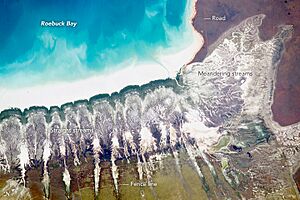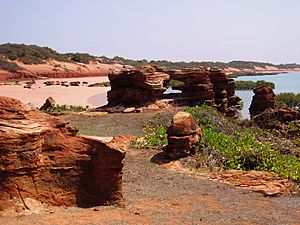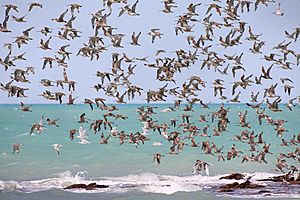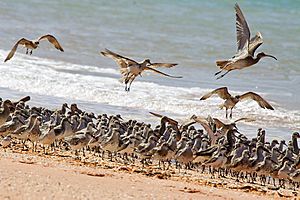Roebuck Bay facts for kids
Quick facts for kids
Designations
|
|
| Official name: Roebuck Bay | |
| Designated: | 7 June 1990 |
|---|---|
| Reference #: | 479 |

Roebuck Bay is a large bay located on the coast of the Kimberley region in Western Australia. The town of Broome is at its northern edge. The bay was named after the ship HMS Roebuck, which was captained by William Dampier when he explored this coast in 1699. The Broome Bird Observatory is also found on the northern coast of the bay.
Contents
About Roebuck Bay
Roebuck Bay is a tropical bay that covers about 550 square kilometers (210 square miles). It has unique red sandy beaches and areas covered in mangrove trees. The eastern side of the bay has many tidal creeks. Around the bay, you'll find grasslands and pindan woodland, which is a type of forest.
The northern shore of the bay has a long, low red cliff, about 2 to 6 meters high. This cliff is made of red soil, which gives the beaches their special red color. Beneath this soil, there's yellowish-red rock from the Cretaceous period. Sometimes, when this rock is visible at the bottom of the cliff, you can even see fossil footprints of dinosaurs!
Along the eastern shore, behind the mangrove creeks, there are flat areas that only get covered by water during very high tides. The soil here is very salty, so not many plants can grow, except for some samphire plants. The land area next to the bay is known as Roebuck Plain, and there's a large cattle station called Roebuck Plains Station there.
Weather in Roebuck Bay
Roebuck Bay has a hot, semi-dry climate. This means it has a wet season and a long dry season. The wet season happens during the Australian summer, from November to March. Most of the year's rain falls then, often as big tropical thunderstorms.
The dry season lasts from May to November. During this time, temperatures are still very warm, but there's hardly any rain. The total rainfall each year varies, usually between 300 to 550 millimeters. In the summer months, temperatures can often go above 38°C (100°F), and it can feel very humid.
Tides in the Bay
Roebuck Bay has a very big tidal range. This means the difference between high tide and low tide is huge. When the tide goes out, about 160 square kilometers (45% of the bay) of mudflats are uncovered. The tide can move quite fast, up to 20 centimeters per second.
Most of these mudflats get covered by water again with each high tide. Very high tides, called spring tides, or strong storms like cyclones, can even flood the land next to the coast. The tides here happen twice a day, with an average change of 5.7 meters. This can range from 1 meter during neap tides (small tides) to an amazing 10.5 meters during the highest spring tides. These big tides are very important for all the plants and animals that live in the bay's intertidal zone (the area between high and low tide).
History of Roebuck Bay
Roebuck Bay is the traditional home of the Jukun and Yawuru Aboriginal peoples. The bay was an important place for them to meet, exchange gifts, arrange marriages, and settle disagreements. You can still see many shellfish middens (piles of shells) along the cliffs and dunes, which show where people used to camp. Local Indigenous people still use the bay's natural resources today, gathering shellfish, fishing, and hunting.
A Sad Event in 1942
During World War II, in 1942, several Dutch flying boats arrived in Roebuck Bay, carrying people seeking safety from the Dutch East Indies. On March 3, 1942, these flying boats were attacked by Japanese Zero-fighter planes while they were anchored in the bay. The flying boats could not defend themselves. Many people were killed, and some drowned. The remains of these flying boats are still in the bay, and some can be seen a few days each year when the tide is extremely low.
On June 7, 1990, a large part of the bay and its surrounding areas, about 34,219 hectares, was recognized as a wetland of international importance. It became Ramsar Site 479 under the Ramsar Convention, which helps protect important wetlands around the world.
Plants and Animals
Roebuck Bay is home to eleven different types of mangrove trees. The mangrove swamps along the eastern and southern edges of the bay are very important. They act as nurseries for young marine fish and crustaceans, especially prawns. There are also large areas of seagrass beds across the bay. These are important feeding grounds for dugongs and green turtles. Other marine turtles and dolphins also visit the bay regularly.
Amazing Waders
The mud and sand flats that are uncovered at low tide are full of tiny invertebrates (small creatures without backbones). These creatures are a main food source for waders, also known as shorebirds. Roebuck Bay is one of the most important places in Australia for these birds to stop during their long migrations or to spend the non-breeding season. It's a key arrival point in August to October for many Australian waders, especially the larger ones that fly non-stop from China to Australia.
Many birds move on to other parts of Australia, but large numbers stay through the summer. Smaller groups of non-breeding birds even stay through the winter. The area is also important for waders flying north in autumn, with many birds leaving in March and April. It's estimated that over 300,000 waders use the bay each year! The northern beaches of the bay and Bush Point are important places for these birds to rest during high tide.
The wader feeding and resting areas in the bay have been identified by BirdLife International as a 928 square kilometer Important Bird Area (IBA). This special area also includes the low-lying grasslands to the east of the bay on Roebuck Plains Station, like Lake Eda, where many waders rest during very high tides.
The bay regularly supports more than 1% of the population of at least 22 wader species, including:
- greater sand plover
- lesser sand plover
- oriental plover
- red-capped plover
- grey plover
- bar-tailed godwit
- black-tailed godwit
- red knot
- great knot
- red-necked stint
- curlew sandpiper
- sanderling
- eastern curlew
- little curlew
- Eurasian whimbrel
- common greenshank
- common redshank
- grey-tailed tattler
- Terek sandpiper
- ruddy turnstone
- Asian dowitcher
- pied oystercatcher
Visiting Roebuck Bay
Broome is a popular place for tourists, and Roebuck Bay is used for fun activities like fishing, sightseeing, and birdwatching. The Broome Bird Observatory does research on shorebirds and teaches the public about them.
Getting to Roebuck Bay
You can reach Roebuck Bay by boat from Broome Wharf, which is about 9 kilometers south of the Broome Post Office and Broome International Airport.
In the 1890s, Roebuck Bay was planned to be the end point of a very long railway line from Angle Pole in the Northern Territory. This railway would have been about 1600 kilometers (1000 miles) long, but it was never built.
Because its waters are calm and protected, Roebuck Bay was chosen in 1871 as the place where the undersea telegraph cable from Asia would come ashore. From there, the telegraph line continued overland to Perth.




